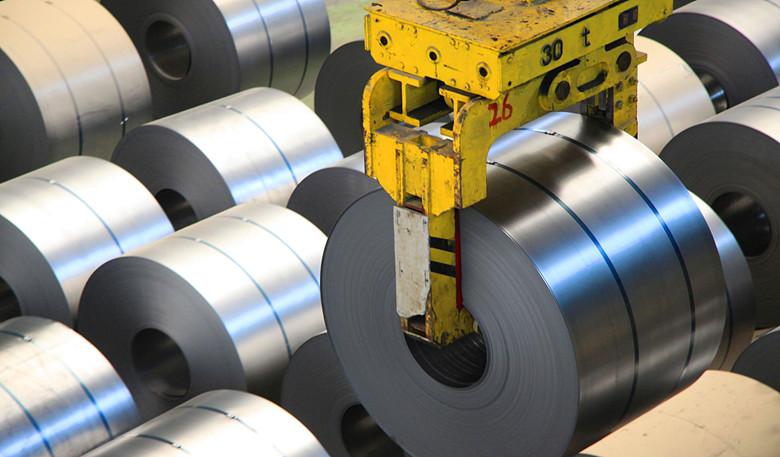Hot rolling
Hot rolling is relative to cold rolling, which is rolling below the recrystallisation temperature, while hot rolling is rolling above the recrystallisation temperature.
Advantages:
Can destroy the casting of steel ingots, refining the grain of steel, and eliminate microstructural defects, so that the steel organization is dense, mechanical properties are improved. This improvement is mainly in the direction of rolling, so that the steel is no longer isotropic to a certain extent; bubbles, cracks and looseness formed during casting can also be welded together under high temperature and pressure.
Disadvantages:
1. After hot rolling, the non-metallic inclusions within the steel (mainly sulphides and oxides, and silicates) are pressed into thin sheets and delamination (lamination) occurs. Delamination greatly deteriorates the properties of the steel in tension along the thickness direction, and there is a risk of interlaminar tearing during weld shrinkage. Local strains induced by weld shrinkage often reach several times the yield point strain and are much greater than those induced by loading.
2. Residual stresses caused by uneven cooling. Residual stresses are internal self-balancing stresses in the absence of external forces, various sections of hot rolled steel have such residual stresses, generally the larger the section size of the steel, the greater the residual stresses. Although the residual stresses are self-balancing, they still have an effect on the performance of the steel member under external forces. Such as deformation, stability, fatigue resistance and other aspects may have a negative effect.
3. Hot-rolled steel products are not easy to control in terms of thickness and edge width. We are familiar with thermal expansion and contraction, as the beginning of the hot rolled out even if the length and thickness are up to standard, the final cooling will still appear a certain negative difference, the wider the negative side width, the thicker the performance of the more obvious. This is why it is impossible to be too precise about the width, thickness, length, angle and edge line of large steel.

Cold rolling
Rolling below the recrystallisation temperature is called cold rolling, generally using hot rolled steel coils as raw material, after pickling to remove oxidation skin for cold continuous rolling, the finished product is rolled hard coil, due to continuous cold deformation caused by cold work hardening rolled hard coil strength, hardness, toughness and plastic indicators decline, so the stamping performance will deteriorate, can only be used for simple deformation of parts. Cold rolled is generally annealed.
Hard rolled coils can be used as raw material in hot dip galvanising plants, as hot dip galvanising units are equipped with annealing lines.
Rolled hard coils generally weigh 20-40 tonnes and the coils are continuously rolled at room temperature against hot rolled pickled coils.
Product characteristics: Because it is not annealed, its hardness is very high and its machinability is extremely poor, so it can only be bent in a simple direction less than 90 degrees (perpendicular to the roll orientation). In simpler terms, cold rolling is the process of rolling on the basis of hot-rolled coils, which is generally a process of hot rolling - pickling - phosphating - saponification - cold rolling.
Cold-rolled is processed from hot-rolled sheet at room temperature, although in the process because of rolling will also make the steel plate warm, but nevertheless is called cold-rolled. As the hot rolled after continuous cold deformation and cold rolled in the mechanical properties of poor, too hard, so must be annealed to restore its mechanical properties, no annealing called rolling hard volume. Rolled hard rolls are generally used to do without bending, stretching products, 1.0 below the thickness of rolled hard good luck bending on both sides or four sides.
In the cold rolling process must use cold rolling oil, the benefits of using cold rolling oil are:
1.Effectively reduce the coefficient of friction, provide the corresponding rolling force, rolling low energy consumption, to obtain satisfactory rolling parameters;
2. Give high surface brightness, rolling delay thickness uniform;
3.Good cooling effect, can quickly take away the rolling heat, to protect the rolls and rolling parts. Good annealing performance, will not produce oil burning phenomenon;
4.Has a short-term anti-rust performance, can provide temporary anti-rust protection for rolling parts.
The difference between cold-rolled and hot-rolled:
1.Cold rolled formed steel allows local buckling of the cross-section so that the load-bearing capacity of the bar after buckling can be fully utilised; whereas hot rolled sections do not allow local buckling of the cross-section to occur.
2. Hot-rolled sections and cold-rolled sections of steel residual stress generated by different reasons, so the distribution on the cross-section is also very different. The distribution of residual stress in the cross-section of cold-formed thin-walled sections is bending type, while the distribution of residual stress in the cross-section of hot-rolled sections or welded sections is film type.
3.The free torsional stiffness of hot-rolled sections is higher than that of cold-rolled sections, so the torsional resistance of hot-rolled sections is better than that of cold-rolled sections.
Post time: Feb-09-2023
